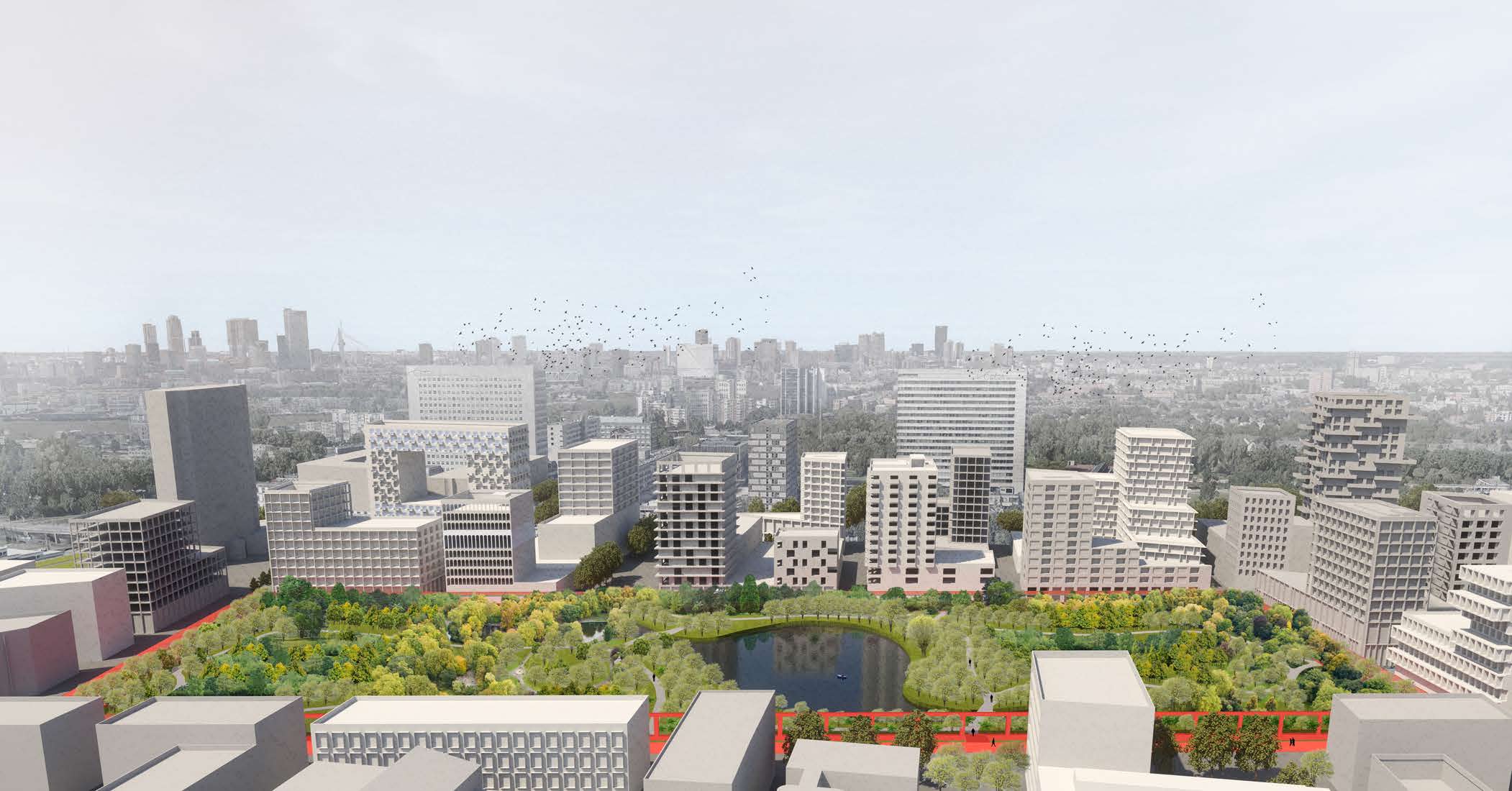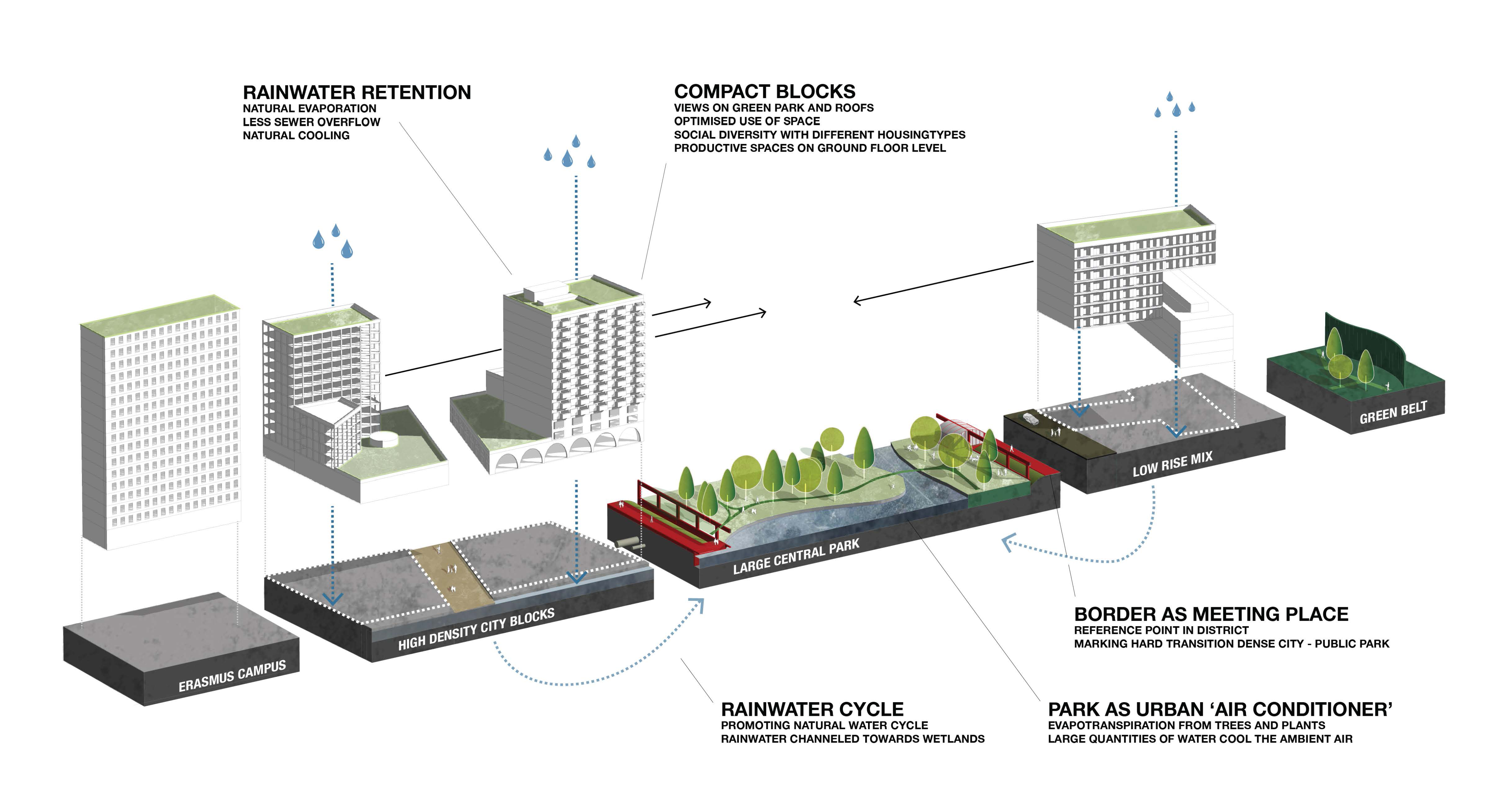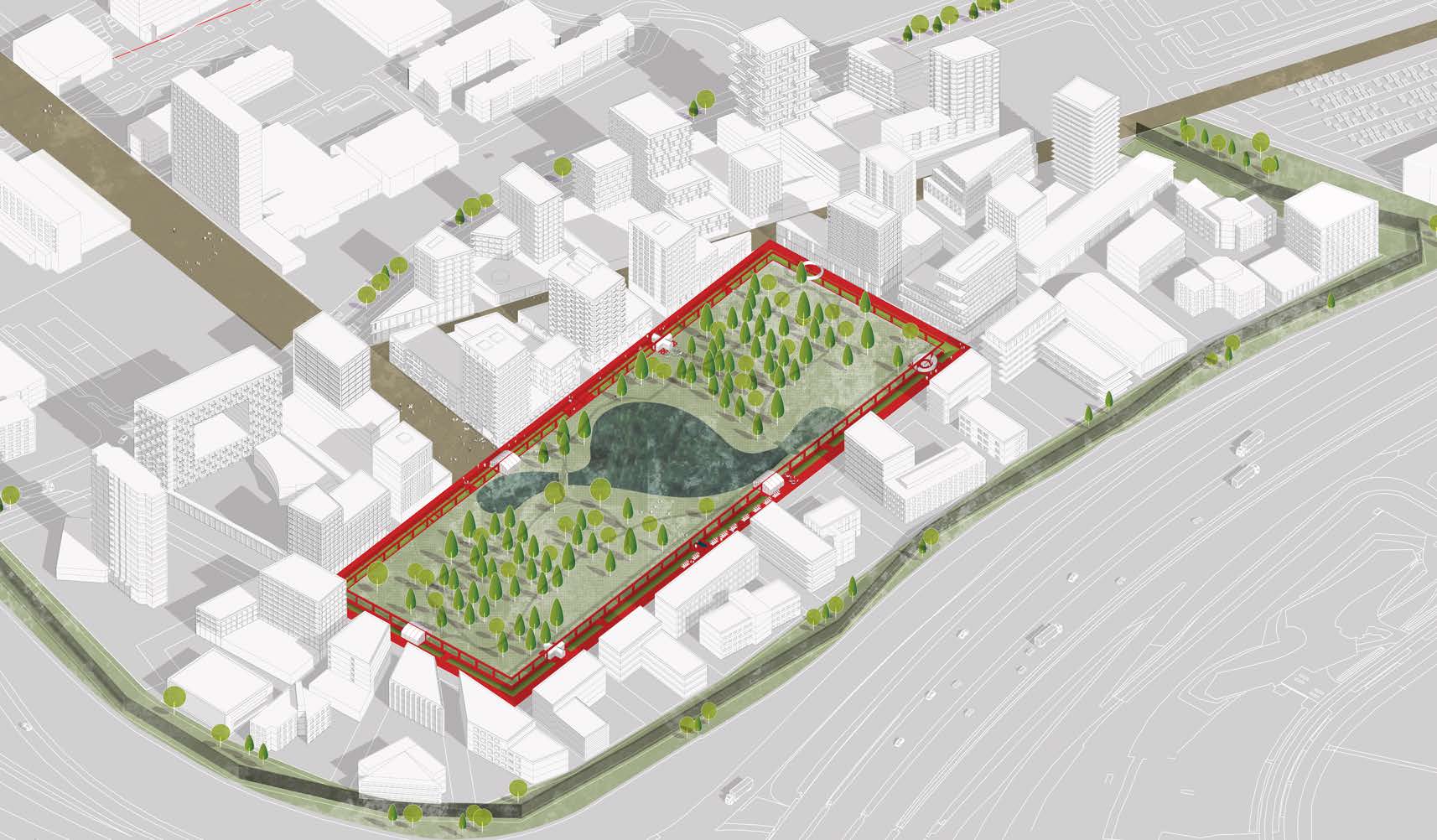Team Brainpark: A New Model for Sustainable Urban Planning

Brainpark
Render: Team Brainpark
A clear objective for new city developments is the creation of dense, and vibrant communities, fundamentally supported by an articulated strategy for sustainable design. Team Brainpark’s proposal for Europan 15’s Rotterdam site, Brainpark, combines these imperatives in a comprehensive design solution.
Team Brainpark Interview
Videography: Kristel Kuiper; Interview: Cullo Studio
Design Strategy
Brainpark has the potential to become a definitive precedent model for sustainable urban planning. Located next to Erasmus University’s bustling campus, it has an expansive green core, as well as a clear connection to Rotterdam’s city centre. In spite of these adjacencies, it does little to take advantage of them, and as a result, this mono-functional business area lacks a vibrant public life. Parking and fences dominate ground floor pedestrian areas and its main corridors are too broad, and lack program that would support street life beyond regular office hours. Significant infrastructural corridors that cause noise and fine-dust pollution dominate making it unpleasant for site occupants. Further complicating this condition is its ownership structure: the Brainpark site is composed of multiple plots with different proprietors.
Team Brainpark’s design strategy begins by exploring the tension between the imperative to create density, and the imperative to further develop and enhance this prime urban location sustainably. Compact streets with strong connections, and a variety of programming and housing all help to generate a vibrant street life. Moreover, maintaining its extensive sustainable surfaces (green spaces) mitigates overheating, so this proposal integrates sufficient and effective quantities of sustainable surface area. Rotterdam suffers from a shortage of large urban parks, so with this, and the aim to create density, the tension between built surface and sustainable green surface comes to the fore. Building more can mean less green surface area. However, it is possible to achieve the best of both worlds: take for example Paris’ Clichy Batignolles, Vancouver’s Joyce Collingwood, London’s East Village and, however disproportionate, Manhattan’s Central Park. Sustainable density in Brainpark is possible at a district level, if it is a density strategy that encourages social vibrance and optimises green surface area, in close coordination.

Developing a comprehensive sustainability strategy to facilitate rainwater retention and park irrigation
Diagram: Keizer-Koopmans / Team Brainpark
This solution creates compact, high-density blocks in the west along a new, articulated connection between the Erasmus University campus and Metrostation Kralingse Zoom. Brainpark’s west side is accessible via this new artery. Furthermore, shading from highrise buildings will not impact it. The west side also experiences fewer challenges with respect to noise and air-pollution.
Proposed new buildings are low-energy, and compact in terms of footprint. Towers mainly consist of small to medium-sized apartment dwellings that accommodate starters as well as university students. High floor to ceiling heights on ground floor levels enable flexibility in use and can accommodate mixed activities from bars and shops, to offices and production spaces. The new diagonal connection and compact side streets generate a mixed and vibrant street life.

Brainpark’s activated perimeter
Render: Keizer-Koopmans / Team Brainpark
The eastern area of the Brainpark site will contain a low-rise mix. Here, existing office buildings can be gradually replaced by low-rise apartment buildings, and single-family homes with gardens. This mix of dwelling types easily integrates social housing in both areas, and ensures greater social diversity. Finally, housing blocks in the east are protected from the highway with an accessible green belt buffer.
The dense, multi-functional Brainpark city is organised compactly around a vast and open public park. The existing water feature expands to a central park of 100 x 300 meters. Located at the heart of the park, it is easily accessible for all users. Due to its size, it encourages a variety of sports and recreational activities, enhancing the park’s activation. The park collects stormwater run-off from all buildings and functions as a veritable urban ‘air conditioner’ for the whole district.
Four fundamental features of Brainpark’s design strategy and redevelopment include:
- Zoning: high density blocks in the northwest, and low-rise buildings in the southwest
- New connections: boulevard from campus to public transport, accessible park, and reduced vehicular traffic
- Functional green: large central park (100 x 300m) and accessible green belt as buffer to highway
- Mixed city: housing mixed with productive and social functions

Brainpark’s ownership, programming, and routes of access
Diagram: Keizer-Koopmans / Team Brainpark
Development Strategy
How do you develop Brainpark with multiple plot owners? This solution proposes minimal changes to the site’s existing layout, and focuses on the division of public versus private to form alliances with the park’s diverse stakeholders.
Brainpark has many different plot owners who may wish to develop their individual initiatives at their own pace. In order to accommodate this, this solution presents a new scheme with few changes to existing property lines. Each plot can be developed separately, enhancing the flexibility of the comprehensive plan. Parking will be accommodated on private plots, and placed below ground.
Key plot points in the mobilisation of this strategy include the following:
- A project office forms the first section of the circuit to function as a new central meeting point
- A new connection to the campus and to the metro at Kralingse Zoom stimulates and enhances site accessibility
- Completion of the circuit marks the perimeter of a large new central city park
- Relocation of companies housed in the Erasmusstaele makes space for mixing
- Reduction of vehicular traffic to a single loop
- Development of the first plots in the west area of the site
- Development of the park into a high-quality green lung for the area
- Individual development of various plots in the district
- Construction of a green buffer zone proximal to the highway
- Development of all plots according to the new zoning plan

A bold landscape element defines the perimeter of the central park
Render: Keizer-Koopmans / Team Brainpark
Team Brainpark’s proposal strategically balances public and private space, yet the final composition is not predetermined because each plot can develop differently.
Comprising a red circuit or perimeter strip, with diverse entry portals, a bold landscape element defines the border of the park. Different functions within its circuit can adapt to different needs, demands, and opportunities. With the terrain sloping toward the park, the edge condition is strengthened simply, but effectively. It marks a threshold to the natural environment, and a hard transition from city to park. The edge of the park is, after all, the edge of the city.
At different locations along the edge circuit, small pavilions integrated in the border offer a range of activities. The first pavilion, built on the extension of the campus-boulevard, is a project office. Coordination of Brainpark’s redevelopment can take place from this location. Other pavilions can host a small bar or cafe with a terrace, providing a viewpoint or a podium for social gatherings. All pavilions will stimulate interaction, gathering, and further activation of the area.
Wouter Keizer, Architect (NL); Ule Koopmans, Architect (NL); Douwe Strating, Architect (NL); Lieke de Jong, Landscape Architect (NL); Anna Decker, Sociologist (NL)
Team Brainpark: Winner Brainpark


